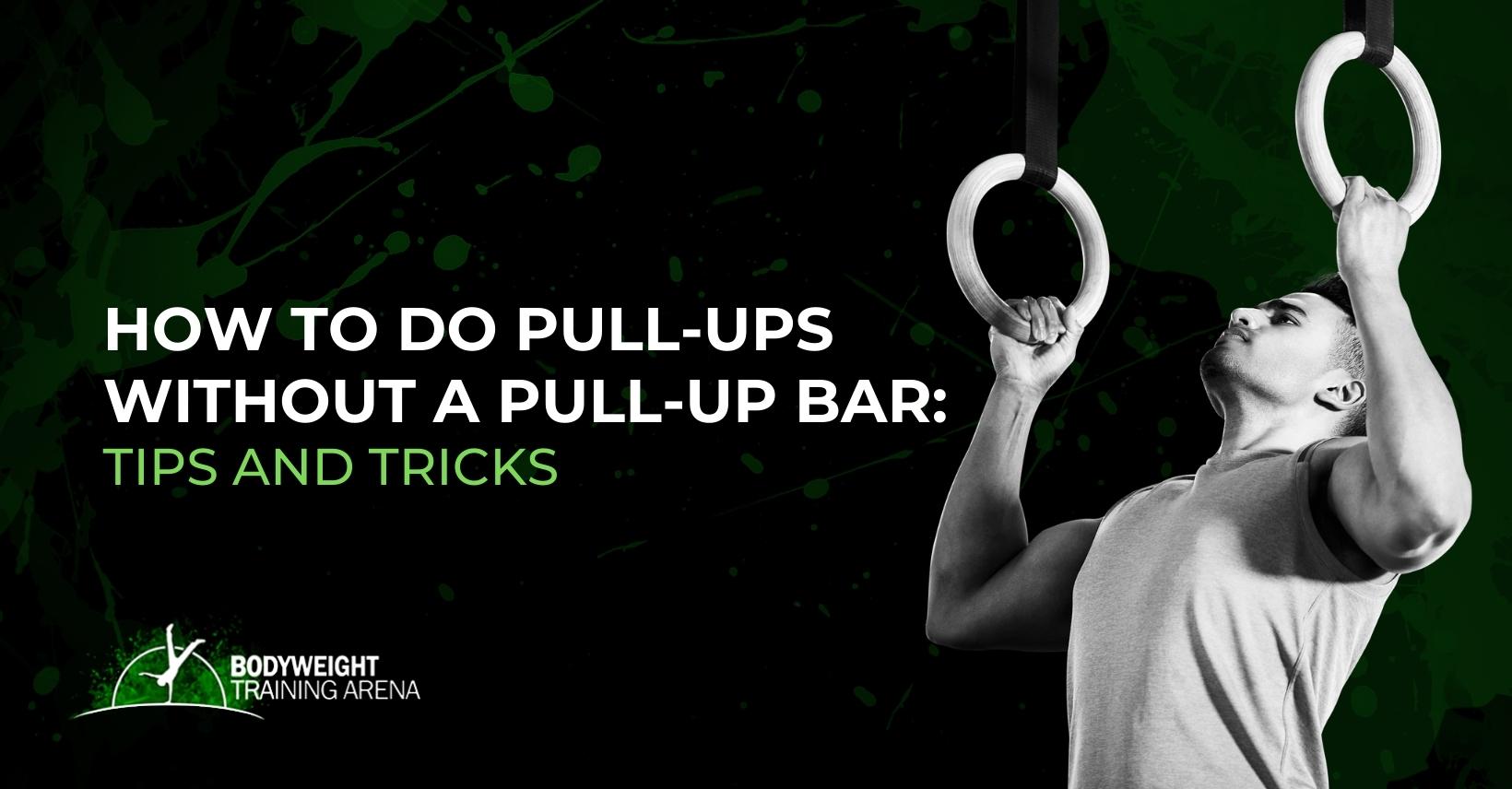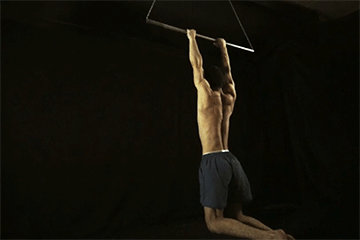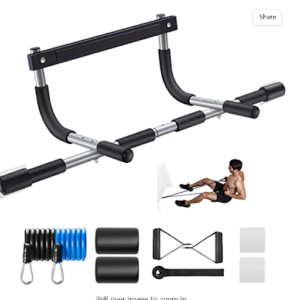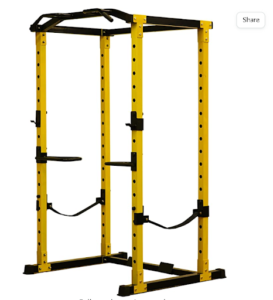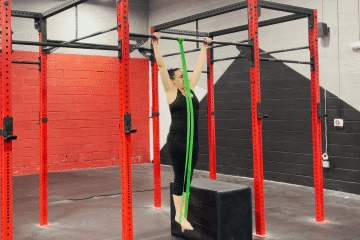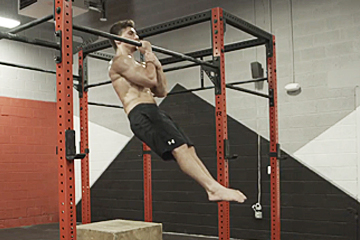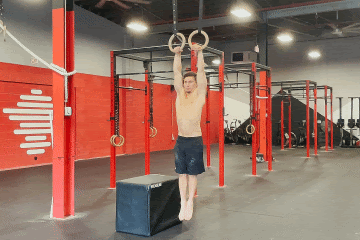Do you want to do pull-ups but don’t have a pull-up bar? No problem!
There are many ways to do pull-ups without a bar. In this blog post, we will discuss:
- 🔎 some of the best tips and tricks for doing pull-ups without a bar
- 🔎 few exercise alternatives
- 🔎 and basic progressions that you can eventually do standard pull-ups.
👊Let’s get started!
What are pull-ups?😱
So, you might be thinking, “Pull-ups? Pssh, easy peasy.” or if you are more on the beginner side: “Why should I care?”
Well, hold onto your hat (or bar in this case), my friend, because there’s more to these vertical acrobatics than meets the eye.
Two words: total gains!
These aren’t just your regular old exercises; they’re the secret sauce to unlocking superhero-like strength and a back that looks like it could take down a brick wall.
But there is more…
Pull-ups are a powerful fundamental exercise.
The pulling movements, both horizontal and vertical, are critical to creating strength, shoulder mobility, and healthy joints that we need for our day-to-day life.
Bottom Line: Wanna be strong till you are 90?
Do the damn pull-ups!
Pull-ups are a great way to build upper body strength. They work your back, shoulders, and arms, and can be done almost anywhere. All you need is something to hang from, like a tree branch or door frame which we’ll talk about more later in the article.
Pull-up is the king of calisthenics pulling exercises since it’s a compound movement that works many muscles in the posterior (back) and anterior (front) chain. The prime movers for your pull-ups are:
- Latisimus dorsi AKA lats
- Biceps
- Rhomboids
- Rear deltoids
- & your core
Although pull-ups look simple, they are technically demanding and require a lot of strength. That’s also why there are still many people who can’t do a pull-up. If you can’t do a pull-up yet, don’t worry! With some practice and dedication, you’ll be able to do them in no time.
Before you dive in, we strongly recommend watching these two videos.
- The Perfect Pull-Up Technique Demystified: Get ready to master the art of pull-ups, complete with insider secrets that will make you feel like a pull-up ninja. Trust me; you’ll be swingin’ like Spider-Man in no time.
-
- Pull-Up Blunders: 6 Common Mistakes: We’re going to dissect those funny (and not-so-funny) moments that might be holding you back from pull-up glory. Spoiler alert: you’re not alone in these blunders!
Now that you know the basics, lets dive in.
🏆Benefits of pull-ups
Aside from building upper body strength, pull-ups also have many other benefits. They are a great way to improve your grip strength, and can also help improve your posture. Additionally, pull-ups are a great way to challenge your body and mind.
Here’s a brief of the benefits of performing pull-ups and why you should include them in your workout:
- ✊ Increased general pulling strength – Pull-ups are staples to building strong pulling mechanics. It’s challenging enough to build relative strength and can be progressed to different pulling.
- ✊ Builds your posterior chain – Pull-ups is a well-known lats builder. However, it also builds other muscles on the posterior chain [INSERT PULL WORKOUT ARTICLE] such as the rhomboid, middle traps, rear deltoids, infraspinatus, and Erectus spinae.
- ✊ Strengthens your core – Not many know this but a proper pull-up form highly activate the abs for stabilization and power transfer. You can build a solid core by doing pull-ups alone.
- ✊ Strengthens your grip – According to research, a strong grip correlates to a long life. Other than that, getting a strong grip is also functional strength for many movement patterns in daily life.
- ✊ Translates to other harder calisthenics skills – If you want to learn the human flag, one-arm pull-ups, or the 📍front lever, then you have to work on your pull-ups first. This sets up a strong base of strength for your other skills in the future.
- ✊ Lesser risk of muscle imbalance – It’s common for people to focus too much on the “mirror muscles” or the muscles you see in the mirror such as your chest, abs, and shoulders. This can lead to muscle imbalances which can ultimately lead to injuries. Muscle balance isn’t only for aesthetics, but it is functional.
Read more here: 📍How to Fix Muscle Imbalance
- ✊Prevents injuries & pains – Speaking of muscle imbalances, having this situation can lead to injuries and pains. Weaknesses, which are often in the posterior chain, lead to movement dysfunction that eventually hurts. The pain you feel can probably come from having weak back muscles because you’re not doing enough pull work. The endless hours sitting down at work worsen the situation. Have some back aches? You might want to consider doing pull-ups.
✨Ideal pull-up equipment
Even though calisthenics boasts training without any equipment, you would still want to get access to some pieces to optimize your training with minimal risk of injury or preventing any damage to furniture.
The number one piece of equipment you would want for pull-ups is, obviously, a pull-up bar. Below are different pull-up bar types to choose from.
🔥Doorway pull-up
The go-to equipment for a pull-up bar is the classic doorway pull-up bar. These bars are easy to install and can be used for a variety of exercises, not just pull-ups. They are also relatively affordable, making them a great option for those on a budget.
It’s also easy to install and doesn’t need any screws. The main issue with this type of pull-up bar is your door frame should be able to handle the loading.
🔥Free-standing pull-up bar
Another popular option is the free-standing pull-up bar. These bars are sturdier than doorway pull-up bars and can support more weight. They are also great for people who don’t have a lot of space, as they can be stored in a closet or corner when not in use.
🔥Power rack
If you have the budget to splurge, a power rack is a great option to have. This equipment offers many other exercises such as a squat rack, bench press bar, and dip station. It’s also great for people who want to do pull-ups with added weight.
You can also read more here about other pull-up bar types: 📍The Best Pull-up Bar
✨Additional equipment
🔥Chalk
If you want to gain the most from your pull-ups, it’s best to chalk up your hands. When your palms get sweaty, the grip becomes a limiting factor. This forms a barrier between your sweat, skin, and pull-up bar so you won’t slip out of the bar.
Workout chalks are usually made of magnesium carbonate which is safe to use. It’s usually used by rock climbers as well. You can purchase it in powder form which is very affordable or in liquid form. The liquid chalk is a bit more expensive but is not messy as the powered version.
We highly recommend chalking up for your pulling work so you can get in more reps without slipping out of the bar or whatever you’re holding.
🔥Resistance bands
If you don’t have proper pull-ups yet, then working with resistance bands is a must. Bands assist in the hardest part of the pull-up so you can get to the top.
Choose the lightest band so you can get a good working set and reps for your pull-ups. If you need to get the heaviest resistance band, go for it.
You can also opt for leg assistance or opt for inverted rows if you need you’re a beginner.
⭐️How to perform pull-ups
- Hold the bar with hands shoulder-width apart or slightly wider depending on your mobility.
- From a dead hang, pinch your shoulder blades together and push down the shoulders.
- Pull your body up towards the wall until your head is over the bar.
- Brief pause at the top position.
- Lower down with control.
- Repeat for reps.
🔎Coaching Pointers:
- Posterior pelvic tilt (PPT) – hips tilted backward to engage your core more
- Shoulders depressed and retracted when pulling
- Ideally, legs are straight or at least legs slightly forward of your hips. If legs are bent because of space limitations, maintain PPT
- Elbows close to your body
🤔How to change the intensity of the pull-up
Like many calisthenics exercises, pull-ups can be progressed. This means whether you’re a beginner or a high-level athlete, there is a pull-up variation that can suit your skill level.
Calisthenics is progressive. This means that the intensity can be changed from easy to hard. It’s the most efficient way to make progress with any exercise.
Here are ways to progress in pull-ups:
💪Easy (Basic progression for Beginners)
- Leg/band-assisted pull-ups
- Work on inverted rows/pulls
- Learn eccentrics
💪💪Hard (Progressions for advanced)
- Adding pauses
- Slower tempo
- Adding weights
- One-arm pull-up progression
- Archer pull-ups
🤜What pull-up grip to use
Pull-ups are performed with an overhand/pronated grip; meaning the palm is facing down. However, there are other pull-up grip orientations that you can use, too. One study shows that the grip options are all viable for building a strong back. However, these grips slightly shift the emphasis on certain muscle groups.
Here’s a brief below:
- Pronated/overhand grip (palms facing downward) – Lats, middle back
- Supinated/underhand grip (palms facing upward) – Biceps
- Neutral (palms facing each other) – Forearms, middle back
Take note that all of these variations still produce excellent back gains so you can choose whichever works for you the best.
🧐What pull-up width to use
In the similar study mentioned above, the effects of different grip widths were also evaluated. The study shows that shoulder-width apart performed optimally will fewer drawbacks involved. The wider grip showed a restricted range of motion when pulling and adds unnecessary tension on the shoulder capsules. The narrow grip activated the biceps and forearms more.
We highly recommend going with the shoulder-width grip as a conclusion. You can also opt for a slightly wider grip to accommodate individual body proportions.
🎯How to do pull-ups without a pull-up bar
Here are options to work with if you still want to build your back muscles through pull-ups even if you don’t have a pull-up bar.
⚡️Gymnastics rings
If you don’t have a pull-up bar, then we highly recommend getting a pair of gymnastic rings. Rings are perfect for pull-ups because you can hang them anywhere. Just go outside and hang on a stable tree branch or a house beam.
Plus, you can also perform on rings inverted rows which is also a great back builder. There are also other exercises you can do on rings such as dips, levers, and push-ups. All of these add intensity to these basics because of the freely moving rings.
Speaking of freely moving, rings also add the great benefit of being more shoulder-friendly. Since rings can move, your body can adjust to its optimal movement pathway to complete a pull-up repetition.
You can also easily change and mix your grip orientation with rings.
Gymnastics rings are an affordable investment that we highly recommend. This tops our list if you want to perform pull-ups without the pull-up bar.
Read more here: 📍Straight Bar Pull-ups vs Gymnastics Rings Pull-ups
⚡️Towel and door
Source: D
Here’s a risky alternative. Using a towel on top of a sturdy door can work as a pull-up bar. Although your grip will be slightly limited due to the nature of the setup.
Safety first! Make sure that you have a solid wooden door that can surely hold up your weight. The last thing you’d want is getting injured and a broken fixture.
⚡️Tree branch
Working out outdoors is great. It offers many benefits such as it’s free, offering fresh air, and space aplenty. You can find a strong tree branch where you can perform pull-ups.
The biggest downside to this is the grip. If you can only find a sturdy tree that’s pretty thick, gripping the branch is going to be harder. The surface also tends to be rough which can get uncomfortable as you go through the reps.
However, a solid tree branch is a great alternative for pull-up bars. You can even prop up your gymnastics rings here!
⚡️House beams
If you have some sturdy house beams visible, you can set them up there for your pull-ups. But just like the door, make sure that the house beam can care for your body weight and more.
Again, the thickness of the beam dictates how easy or hard it is to grip. Wider beams offer a challenge for your grip strength and stability. Narrower beams are much easier to grasp. The surface also plays an important role in your grip.
⚡️Playground and parks
It’s time to bring out your inner child! Don’t get too embarrassed working out in the monkey bars. After all, these are meant for people to play and exercise.
The great thing about playgrounds and parks is that they offer a wide variety of options. You can use the monkey bars, swing sets, and more!
And since these structures are public, they have to be made with high-quality material that can surely support your weight.
⚡️Floor pull-ups
Source: Tapp Brothers
Here’s an interesting option: floor pull-ups.
In this set-up, you just need a slippery floor where you can glide your body and something that can help your hand stick to the floor like chalk. This setup works with similar muscles and follows almost a similar movement pathway to the pull-ups.
🧐Frequently Asked Questions
🔎Should I work on pull-ups?
Most definitely! Pull-ups are calisthenics fundamental. If you want a balanced and overall strong body, then pull-ups are a must. If you don’t work on pull-ups, at least perform other pulling exercises such as inverted rows or weighted variations such as the barbell row.
Pull-ups are accessible and can be done anywhere. There’s no reason to skip on the gains you can get from pull-ups if you don’t have any other pulling work done.
🔎How many pull-ups should I be able to do?
If you’re a beginner, start with the easier pull-up progressions first. If you can’t do pull-ups properly, the most probable reason is that you’re not simply strong enough to perform the exercise.
Here are some pointers for the pull-up technique: 📍11 Dumbest Pull-up Mistakes You Need to Avoid
There is no actual count on how many pull-ups you should be able to perform, but beginners should be able to perform at least 5 – 10 pull-ups. It doesn’t matter if you’re a man or a woman as a 2016 meta-analysis show that sex difference doesn’t offer any significant difference in resistance training response.
We’ve opted for the 5-10 reps to show a good baseline of relative strength.
🔎What exercises can I do instead of pull-ups?
If you don’t want to do any pull-ups, then there’s no problem. There are other back exercises you can work on that don’t involve pull-ups.
Read more here: 📍CALISTHENICS BACK EXERCISES
For weight training exercises, you can always opt for the lat pulldown (preferably the kneeling variation) offers as a good substitute as recommended in a recent 2018 published paper. However, take note that this doesn’t translate fully to pull-ups.
If you want to learn pull-ups, then you have to directly train them. Specific Adaptations to Imposed Demands or known as the SAID principle govern your goals. You get strong on what you work on.
🔎Should I work on kipping or strict pull-ups?
For those who don’t know, the kipping pull-up is a common technique in CrossFit that uses a pump from the lower body to generate momentum so you can easily perform a pull-up.
Strict pull-ups are slow and controlled pull-ups. All the force used to perform the pull-up comes from the prime movers.
In general, you would ALWAYS want to learn strict pull-ups first because it strengthens your muscles and joints and also teaches a good movement pathway. Kipping relies too much on momentum and can be dangerous to your joints if you’re not prepared enough.
If you want to learn kipping pull-ups, master your strict pull-ups first!
Read more here: 📍Kipping vs Strict Pull-ups
📌Takeaway
Pull-up is an amazing exercise. There’s no excuse not to do them.
And if you don’t have a pull-up bar, that’s fine too! There are still plenty of ways to perform this exercise without one. Use what’s available to you and be creative.
Most importantly, focus on your form and technique. If you can’t do strict pull-ups yet, then you have to revert back to the basic inverted rows.
You can also opt for a complete beginner exercise below:
📍Full Calisthenics Beginner Workout
But for better, faster, and safer progress, it’s always best to opt for a PERSONALIZED and ADAPTIVE calisthenics approach. This means that your program should be catered to your specific goals, lifestyle, and current skill level.
If this is something interested in, try out our 7-day free trial for the ultimate calisthenics experience.
Beginners to Advanced athletes are all welcome!

